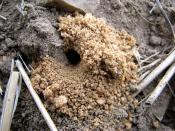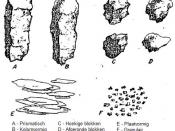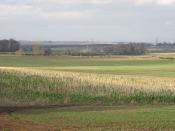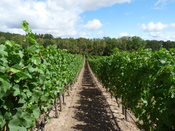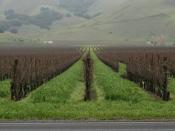Vineyard Floor Management I. Clean cultivation: 1. conserves moisture 2. destroys organic matter at surface 3. may damage soil structure 4. changes soil porosity-root growth is restricted 5. earthworm populations are lower 6. suppresses root growth in upper layer 7. increases the breakdown of nitrogenous compounds into nitrates.
8. May develop hard pan.
COVER CROPS Choice and performance are site specific, so test in a few rows before deciding.
Two types: 1) disked or 2) perennial sod Considerations: 1. costs vs. benefits 2. irrigation method 3. tillage practices 4. nitrogen needs 5. frost concerns Cover crops are generally only grown in row middles, with under-row vegetation controlled by mulch, herbicide, or tillage.
Advantages of cover crops: 1. provide organic matter for the soil 2. provide mulch for under-row 3. increase water infiltration rate 4. control erosion 5. reduce dust in vineyard.
6. Dry out and stabilize the soil in wet areas 7.
Facilitate machinery access in spring 8. Act as host for predators?? Disadvantages of cover crops: 1. must cultivate to prepare a seed bed 2. can be expensive to sow and maintain 3. legumes may be a more expensive source of N than fertilizer.
4. Increase frost risk 5. Competes for water and nutrients Monocultures are often used, but this could be a mistake: 1. could develop soil borne diseases or plant diseases 2. local niches such as sand streaks in the vineyard 3. differing soil nutrient availability in some areas may be unfavorable for single species Multiple species (polyculture): 1. providing multiple species in a mix may enable one species to thrive in areas where another might be weak.
2. Attract a wide diversity of insects.
Cover crops for disked vineyards: 1. Grown for high biomass to add organic matter to the soil. Continual use of this organic matter enhances soil microbial populations, improves soil structure, and improve nutrient cycling.
2. In general, they are sown in the fall and disked under in the spring --- referred to as "green manure".
3. Usually one or two types: pure legumes or legume/grass mix.
a. pure legumes: usually a blend of bell beans, vetch, and field peas. Used to add a large amount of available N to the soil. Problems: produce most of the N in the spring; some peas are shallow rooted and subject to drought, vetch can become a weed.
b. Legume/grass mixes---additions of grasses such as barley, oats, or cereal rye in a mix gives several benefits: fibrous roots of grasses greatly enhance soil structure and water penetration; take up excess nitrogen from the soil which improves the growth and n-fixing ability of the legumes. Typically barley/vetch or oat/vetch are inexpensive and frequently used.
TIP-a green manure crop can add up to 150 lbs/N/acre, which may induce too much vigor in some vineyards. Consider mowing instead-adds about 30-40 lbs/N/acre.
Non-tilled vineyards: trend now is toward non-tillage. Sow winter annual species that will reseed themselves and die in the spring/early summer. These species will regenerate themselves in the fall rains.
Examples: annual clover, bur medic, 'Blando' brome and 'Zorro' fescue.
Most will require replanting every 3 - 4 years to keep populations high.
Burr medic-well adapted to California's climate and does well in neutral to high pH soils; it is occasionally a part of native vegetation. Good at reseeding, produces lots of hard seed that will withstand disking.
Clover-performs best in acid to neutral soils Subterranean clover-does well in neutral to alkaline soils 'Zorro' fescue-expensive and mostly used on hillside, serpentine, and low fertility soils.
Perennial cover crops: provide a permanent cover that offers year-round traction and ease of management.
1. perennial clovers-white and strawberry are low growing and add nitrogen, but may be invasive and compete with vines for water.
2. Birdsfoot trefoil (a legume)-slow to establish, but grows a low dense cover 3. Orchardgrass and tall fescue-can be vigorous and grow into the summer if cool and water is available. May be used to devigorate vines.
4. California natives-becoming very popular in both North Coast and Delta vineyards. In drip irrigated vineyards, they will shut down in summer. The seed is expensive initially, but over the life of the planting can be inexpensive. It is important to select species that are adapted to the climate of your vineyard.
Sod culture can also be the source of mulch under the row-referred to as 'mulching mowers' or 'mow and throw'.
Sod culture ("grassing down") should be used where erosion is a primary consideration.
Sod culture will eliminate grape roots in the upper 6-8 inches of soil.
Sod culture should not be practiced in dry-farmed sites or sites with limited water.
"Mow and throw"-placing vineyard floor mowings under vine row. Most effective with high biomass plants.
1. controls weeds 2. reduce evaporation 3. improves soil structure through the activity of soil micro-organisms.
4. Improves root branching and encourages root development near soil surface.
5. Decreased herbicide costs 6. Improved water infiltration 7. Increased shoot growth 8. Increased yield
